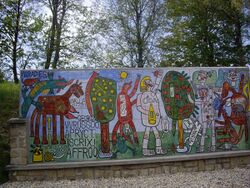Medicine:Gugging
| Gugging | |
|---|---|
 The Gugging building in 2010 | |
| Geography | |
| Location | Austria |
| Organisation | |
| Type | Psychiatric hospital |
The Maria Gugging Psychiatric Clinic, known as Gugging, was a psychiatric institution located on the outskirts of Vienna, Austria.[1] Several of its patients became known for their Outsider Art, and are referred to as the Gugging Artists. Today, several artists live in a dedicated art center at Gugging, known as the Art Brut Center Gugging, which also includes the Museum Gugging and the Gallery Gugging. In stark contrast, Gugging has a darkened history during the time of the Nazi Regime, when hundreds of mental patients were murdered or abused as part of the Nazi Regime Euthanasia Program.
History during the Nazi regime
Historian Herwig Czech told the Austrian Press Agency that Gugging was the scene “of some of the most barbarous medical crimes committed in Austria” during the Nazi Regime. Approximately 400 patients were killed by Doctor Emil Gelny by poisoning and electric shock. Rudolf Lonauer was the attending doctor for 112 deaths and typically murdered his patients - mainly women - with an overdose of drugs. Patients also died from lethal injection, malnutrition, and infectious diseases. New research has also shown that between November 1940 and May 1941 a total of 675 people were taken from the clinic to the euthanasia center at Hartheim castle near Linz, where they were gassed. Of these, 116 were children and teenagers between the ages of four and 17.[2]
By 1940, rumors of euthanasia at Hartheim began to spread. Anna Wödl, a nurse and the mother of a disabled child living at Gugging, attempted to save the life of her son by petitioning against his relocation to Hartheim. She was assured that he would not go to Hartheim, but was instead taken to another children's institution, Am Spiegelgrund, where he died soon after he arrived.[3]
The Gugging Artists
In the late 1950s, psychiatrist Leo Navratil (1921-2006), of the Maria Gugging Psychiatric Clinic, had his patients produce drawings for diagnostic purposes. The following year he discovered artistically talented individuals in his ward - a finding that was confirmed by Jean Dubuffet, the French artist who coined the term Art Brut (also known as Outsider Art). Navratil's first book Schizophrenie und Kunst (Schizophrenia and Art) was published in 1965. Attracted to the clinic by this work, many Viennese artists visited Gugging. In 1970 the first exhibition of the "Gugging Artists" took place in a Vienna gallery. Thereafter, the "Gugging Artists" were frequently presented in galleries and museums.
House of Artists
The "Center for Art and Psychotherapy" was founded by Navratil in 1981. He invited artistically talented patients to live in the house, which serves as living space, studio, gallery and meeting place. With the founder's retirement in 1986, Johann Feilacher became his successor. Feilacher stressed the role that art played at Gugging and went on to change its name to the "House of Artists" (German: Haus der Künstler). Within Europe, the House of Artists is regarded as a model for psychiatric reforms based on art therapy as a means to reintegrate clients into society.
Presently, a cultural center is located next to the House of Artists. It is known as the "Art / Brut Center", and consists of a museum, a gallery and a public studio. The museum contains the works of the Gugging artists, and also hosts traveling Art Brut exhibitions, which include artists such as Martin Ramirez and Adolf Wölfli. The museum building also hosts a public studio that is open to all, but is mainly used by individuals who have undergone or are receiving psychiatric treatment. Together the museum, the gallery, the "House of Artists" and the public studio, are known as the Art / Brut Center Gugging.
In popular culture
In early 1994 David Bowie and Brian Eno visited the Gugging psychiatric hospital to interview and photograph the celebrated artist-patients famous for their "Outsider Art".[4] Artistic materials favored by the Gugging's residents had a powerful influence on production strategies in the studio [4] during the Bowie / Eno collaboration. In March 1994 a three-hour piece (mostly dialog) further inspired the process of the 1995 concept album Outside.
Philipp Weiss's Ein schöner Hase ist meistens der Einzellne is based on the real-life story of Ernst Herbeck (1920–1991) and August Walla (1936–2001), two schizophrenic artistic patients of Gugging. Projekttheater Vorarlberg performed a production of the play at Alte Hallenbad Feldkirch from December 2013.[5]
References
- ↑ http://www.gugging.at/en/besucherinfo/kontakt-anreise
- ↑ "Nazis killed hundreds at Austrian mental hospital". The Local. http://www.thelocal.at/20141125/nazis-killed-hundreds-at-austrian-mental-hospital. Retrieved 14 February 2017.
- ↑ "Alfred Wödl". Germany National Memorial. http://www.t4-denkmal.de/eng/Alfred-Woedl. Retrieved 14 February 2017.
- ↑ 4.0 4.1 Moody, Rick (10 September 1995), "Returning to the Sound of Those Golden Years", New York Times, https://www.nytimes.com/books/97/04/27/reviews/moody-bowie.html, retrieved 29 October 2013
- ↑ "Projekttheater Vorarlberg nimmt schizophrene Künstler in den Fokus" (in German). Vol.at. 13 December 2013. https://www.vol.at/projekttheater-vorarlberg-nimmt-schizophrene-kuenstler-in-den-fokus/3799037. Retrieved 20 April 2020.
External links
- Art/Brut Center Gugging website
- Short Film on Gugging by The Museum of Everything // www.musevery.com
[ ⚑ ] 48°18′47″N 16°15′29″E / 48.313°N 16.258°E


